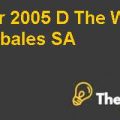
Analysis of Value at Risk of a portfolio
The key purpose for managing risk is to evaluate the risk and improve the performances of consolidated value of a firm to achieve profitability. Currently the benchmark tool for measuring the risk is VAR (Value at Risk). VAR evaluate the maximum loss a value of a portfolio has for a given interval on a pre-determined period of time. It is commonly used in brokerage houses, investment banks and institutions to measure a risk on their portfolios.
In this study the value at risk is determined under the following approaches:
- Historical Simulation Approach
- Exponential Weighting Methodology of the historical simulation approach
- Model Building Approach
- Backtesting under unconditional Coverage
- Backtesting under Conditional Coverage
The findings of this study are as follows:
Historical Simulation Approach:
The Historical simulation approach is based on the historical data of the company. The prices of stocks are taken on daily basis and daily returns are calculated from it. The daily variances between these returns come out and the value at risk calculated from it with the percentile is applied on it. The value at risk tells you about the riskiness a price has on a portfolio. The positive outcome of this approach is the simplicity in implementation. The benefits of this method are its simplicity to implement and its negative aspect is that it requires a large amount of data for calculation which is extensive to calculate.
Exponential Weighting Methodology:
Exponential Weighting Methodology is a technique which is used to calculate the time series for producing the smooth data to forecast the possibilities of returns. This methodology commonly is used in the financial market.
Model Building Approach:
This model is used for the long and short positions of stocks, bonds and commodities. The model is used for the changes in the returns variables through the historical data. From this method the value at risk can be calculated easily by calculating the mean of returns, standard deviation of the returns and the correlation of the underlying value of the assets.
Backtesting of VAR
Backtesting is the procedure for evaluating the profit and loss for comparing the estimated VAR.
In the backtesting approach there are two test used in this case for calculation of VAR. First test is known as the proportion of failure or un-conditional coverage and second test is known as the conditional coverage ratio.
The unconditional coverage:
Unconditional coverage calculates from the exceptions of days and the holding periods of their length. The exceptions are less than the selected interval level, it represents that the risk is over estimated and if it is higher than the interval level then the under estimation of the risk for a particular portfolio’s VAR. The exceptions must truly be showing the exact result as the interval level. If this possibility is matched then it shows that the portfolio’s VAR in reality is the actual figure.
Conditional Coverage:
Conditional coverage of backtesting techniques determined the occurrence of losses on frequency basis. It works on the same basics used in the POF and the only difference in this method is the independence of the exceptions. In this if VAR is exceeded from the interval level then the result will show the value as 1 and if the interval level stays lower than the interval level then it shows the value as 0.
If 1 value shows than it means that the violation occurs and if 0 values shown in the test than it mean that no violation occurred mean no losses occurred during this period of time................
This is just a sample partial case solution. Please place the order on the website to order your own originally done case solution.












